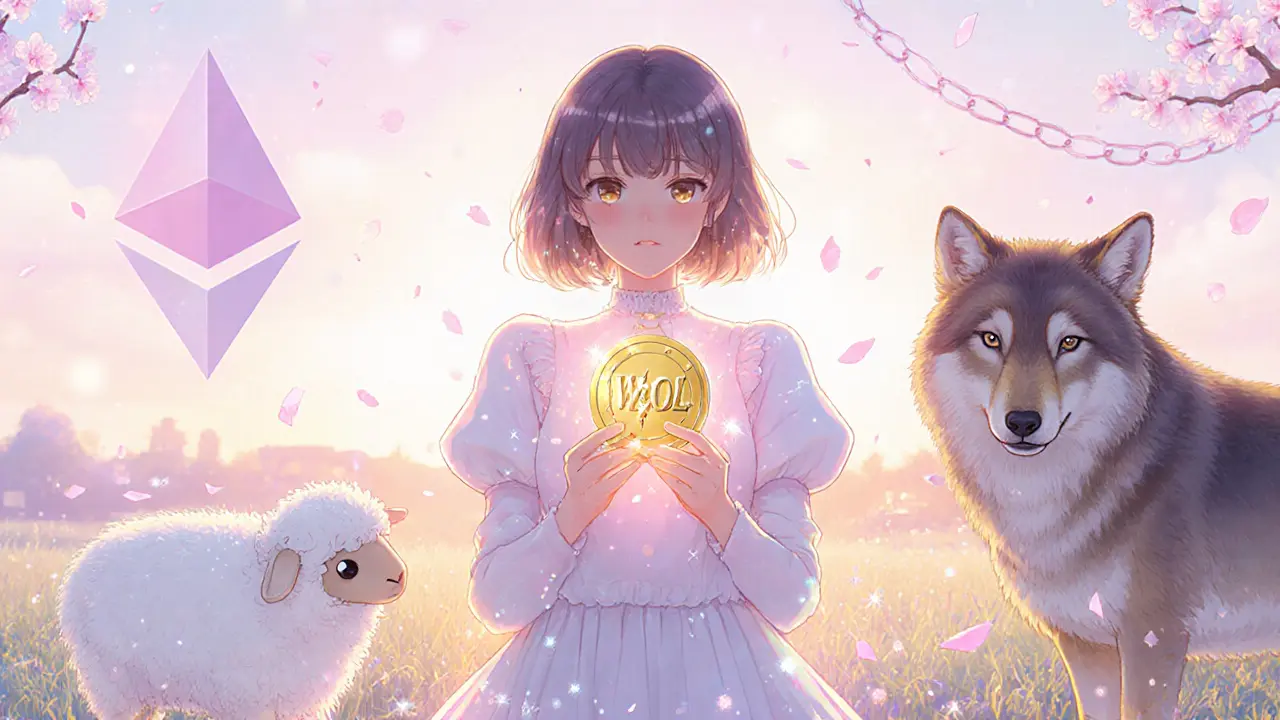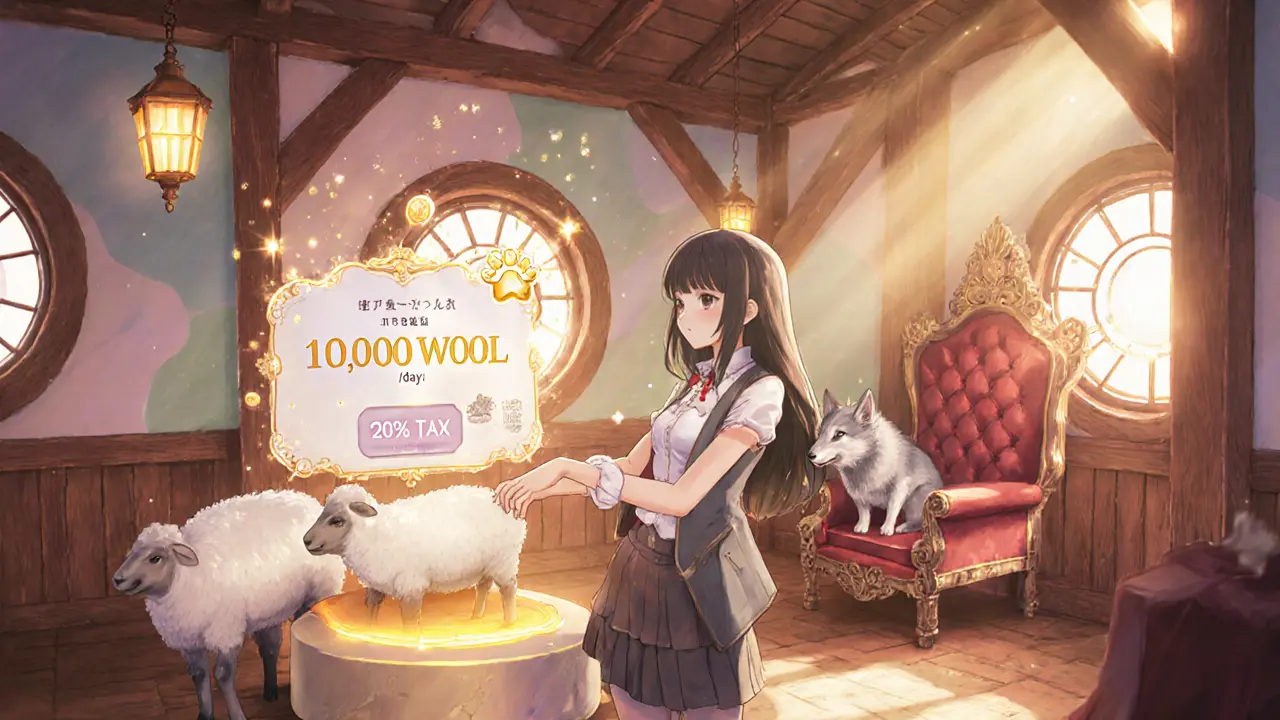What Is Wolf Game WOOL (WOOL) Crypto Coin - Complete Guide

WOOL Token Earnings Calculator
Token Parameters
About WOOL Token
WOOL is the native token of Wolf Game, a play-to-earn NFT game on Ethereum.
Each Sheep NFT generates 10,000 WOOL/day when staked in the Barn.
A 20% tax is applied on earnings, which goes to Wolf NFT holders.
Your Earnings Projection
TL;DR
- WOOL is the native ERC‑20 token of Wolf Game a blockchain‑based play‑to‑earn NFT game on Ethereum.
- 5billion token cap, 10000WOOL per day per staked Sheep NFT, 20% tax goes to Wolf owners.
- Buy WOOL on major DEXes, stake Sheep in the Barn, and claim via “shearing”.
- Deflationary tax and capped supply set it apart from tokens like AXS, SAND or MANA.
- High gas fees and volatility are the main risks; price predictions are speculative.
WOOL is the native ERC‑20 utility token of Wolf Game, a blockchain‑based play‑to‑earn NFT game launched on Ethereum in November 2021. Players earn WOOL by staking Sheep NFTs, use it for in‑game actions, and pay a 20% tax that goes to owners of Wolf NFTs who protect the Barn. In simple terms, WOOL functions as both the game’s money and its governance layer.
Understanding the Core Tokenomics
At launch the contract set a hard cap of 5billion WOOL. Each day a staked Sheep NFT generates exactly 10000 WOOL. The “shearing” process lets you claim the accrued amount, but the protocol automatically deducts a 20% tax. That tax is redistributed to Wolf NFT holders, creating a built‑in deflationary pressure: the more Wolves you own, the larger your share of the tax pool.
The token conforms to the ERC‑20 Ethereum’s standard for fungible tokens and lives at contract address 0x8355dbe8b0e275abad27eb843f3eaf3fc855e525. Because it’s an ERC‑20, WOOL can be moved to any DeFi platform that supports Ethereum, swapped on Uniswap, or stored in any standard wallet (MetaMask, Ledger, etc.).
How to Get Started - From Wallet to Wool
- Set up an Ethereum the public blockchain that powers WOOL and all related NFTs‑compatible wallet (MetaMask is the most common).
- Buy some ETH to cover gas fees. Even a small amount (≈0.01ETH) can cover a single shearing transaction.
- Visit an NFT marketplace like OpenSea and purchase a Sheep NFT a digital collectible representing a sheep in Wolf Game or a Wolf NFT a digital collectible that can attack other players and earn tax revenue.
- Connect your wallet to the Wolf Game dApp and stake your Sheep in the Barn the on‑chain staking hub where Sheep generate WOOL. The UI will show a daily yield of 10000 WOOL per Sheep.
- When you feel the reward is high enough, hit “Shear”. You’ll receive 80% of the accumulated WOOL; the remaining 20% automatically goes to the Wolf tax pool.
If you own Wolves, you can claim a share of the tax pool by staking your Wolves in the “Den”. The more Wolves you have, the larger your slice of the tax revenue.
Gameplay Mechanics - Risk, Reward, and Strategy
The game’s core loop is a classic predator‑prey scenario turned into an on‑chain economic experiment. Sheep generate steady income, while Wolves can launch attacks that steal a portion of a Sheep’s unclaimed WOOL. Attacking costs a small amount of WOOL, adding another layer of decision‑making: do you spend WOOL to try and profit, or let your Sheep keep earning?
This risk‑reward design forces players to balance two opposing forces:
- Harvest timing: Claim too early and you leave money on the table; claim too late and you risk a Wolf raid.
- Tax exposure: The 20% tax reduces your net earnings but fuels a separate revenue stream for Wolf owners.

How WOOL Stacks Up Against Other Play‑to‑Earn Tokens
| Token | Blockchain | Supply Cap | Primary Utility | Deflationary Mechanic |
|---|---|---|---|---|
| WOOL Wolf Game token | Ethereum | 5B | In‑game rewards & governance | 20% tax on shearing (goes to Wolf owners) |
| AXS Axie Infinity governance token | Ethereum | 270M | Staking & governance | Burn on certain purchases |
| SAND The Sandbox utility token | Ethereum | 1B | Land & asset purchases | Burn on marketplace fees |
| MANA Decentraland token | Ethereum | Uncapped (inflationary) | Virtual land & goods | None (purely inflationary) |
WOOL’s unique tax‑to‑Wolf model creates built‑in scarcity that most other P2E tokens lack. While AXS, SAND and MANA rely on burn‑or‑inflation mechanisms, only WOOL directly rewards a competing class of NFT (Wolves) for protecting the ecosystem.
Risk Factors & Practical Considerations
Every crypto‑gaming project carries a set of known risks, and WOOL is no exception:
- Ethereum gas fees: Frequent shearing or attacking can become costly when network demand spikes. Players often wait for low‑traffic windows or use layer‑2 bridges, but those add complexity.
- Market volatility: WOOL’s 24‑hour volume is under $10k (as of September2025). Small trades can move the price dramatically, making short‑term speculation risky.
- Supply dynamics: The capped supply sounds reassuring, but the 20% tax continuously redistributes tokens, which can lead to short‑term supply shocks if many Wolves claim at once.
- Adoption ceiling: Wolf Game targets crypto‑savvy users. Expanding to mainstream gamers would likely require a layer‑2 migration or a cross‑chain bridge, both of which are still in development.
All of these factors mean that potential investors should treat WOOL as a high‑risk, high‑reward asset and only allocate capital they can afford to lose.
Price Outlook - What Do the Numbers Say?
Analytics firms like CoinLore have projected WOOL could reach $0.2097 by 2026 and even $3.42 by 2041, based on historic price patterns, RSI/MACD signals and AI‑driven modeling. Those models assume continued growth in the P2E sector and significant reductions in Ethereum gas fees (e.g., after full Ethereum 2.0 rollout). However, the forecast also warns of “substantial uncertainty” because the token’s liquidity is thin and the community size remains modest.
In practice, price movements are tightly linked to three variables:
- New player onboarding - more Sheep and Wolves equals more WOOL generation and tax revenue.
- Gas fee environment - lower fees make frequent gameplay viable, boosting demand for WOOL.
- Ecosystem updates - additional game modes or cross‑chain bridges can spur fresh speculation.
Community, Development & Future Roadmap
The Wolf Game Discord (≈4k members) is the main hub for strategy discussion, bug reports, and roadmap updates. Developers release quarterly “Woolpapers” detailing upcoming mechanics, such as a “Marketplace” where players can sell rare wool‑derived items for other NFTs.
Long‑term success hinges on two technical milestones:
- Layer‑2 integration (e.g., Arbitrum or Optimism) to slash gas costs.
- Cross‑chain bridges to bring non‑Ethereum users into the game.
Both are actively being explored, and early testnets hint at a potential August2025 launch on Optimism. If successful, the lower fee environment could unlock daily micro‑transactions, dramatically increasing WOOL’s utility and demand.
Quick‑Start Checklist
- Install MetaMask and fund with ETH.
- Buy a Sheep or Wolf NFT on OpenSea.
- Connect wallet to the Wolf Game dApp.
- Stake your Sheep in the Barn to earn 10000WOOL/day.
- Shear when the reward feels worth the 20% tax.
- If you own Wolves, stake them in the Den to collect tax revenue.

Frequently Asked Questions
What is the main purpose of the WOOL token?
WOOL serves as the reward currency for staking Sheep, the tax pool for Wolf owners, and the governance token that lets holders vote on ecosystem upgrades.
How is WOOL generated?
Each active Sheep NFT produces exactly 10000 WOOL per day while staked in the Barn. The tokens are minted on‑chain and added to the total supply.
Can I trade WOOL on centralized exchanges?
WOOL is primarily listed on decentralized platforms like Uniswap and SushiSwap. A few smaller centralized exchanges have added the pair, but liquidity is limited.
What are the biggest risks for holding WOOL?
High Ethereum gas fees, low trading volume, and the niche player base can cause price spikes and make everyday gameplay expensive. Regulatory changes to NFTs could also affect the ecosystem.
Is there a way to reduce the 20% tax on shearing?
The tax is hard‑coded into the smart contract to reward Wolf owners. The only way to lower its impact is to own Wolves yourself, so you earn a share of the tax pool.
Dale Breithaupt
Wolf Game’s WOOL token is an interesting experiment in on‑chain economics.
It rewards passive income via staked Sheep while taxing that income to benefit Wolf owners.
The 20 % tax creates a built‑in incentive for players to acquire both asset types.
Because each Sheep mints exactly 10 000 WOOL per day, the supply growth rate is predictable.
However, the actual net issuance depends on how many Sheep are actively staked at any moment.
High gas fees on Ethereum can make the “shearing” operation pricey, especially when the network is congested.
Players often wait for low‑traffic windows or layer‑2 solutions to keep costs reasonable.
The capped supply of 5 billion WOOL adds a theoretical scarcity, but the continuous minting offsets that in practice.
Market liquidity remains thin, with most trades occurring on Uniswap, which can cause slippage on larger orders.
The tax pool redistribution to Wolf holders provides a secondary revenue stream, encouraging a predator‑prey dynamic that is unique among play‑to‑earn games.
If a large number of Wolves claim the tax at once, the sudden influx of WOOL can depress the price temporarily.
Conversely, a surge in new Sheep purchases can boost daily minting and increase demand for the token.
The upcoming layer‑2 integration on Optimism aims to reduce gas costs dramatically, which could unlock daily micro‑transactions.
Should that rollout succeed, we might see a spike in both staking activity and token velocity.
Overall, WOOL offers high‑risk, high‑reward potential, and anyone considering it should only allocate capital they’re prepared to lose.
Rasean Bryant
Great overview! The guide breaks down the tokenomics clearly, making it easy for newcomers to understand how staking works and what the tax implications are.
Angie Food
meh, another meme coin with fancy sheep, not worth your time. The whole tax thing is just a cash‑grab for Wolf owners, and the price will probably tank once the hype dies.
Jonathan Tsilimos
The protocol delineates a deterministic emission schedule whereby each Sheep NFT accrues ten thousand WOOL units per diem; concomitantly, a statutory twenty percent levy is remitted to Wolf NFT custodians, thereby engendering a bifurcated incentive architecture.
jeffrey najar
Hey folks, if you’re just getting started, remember to keep some ETH handy for gas. Even a tiny amount can cover a shear, and the rewards add up quickly once you’ve got a few Sheep in the barn.
Rochelle Gamauf
It is imperative to recognize that the 20 % tax is immutable; circumventing it is unfeasible, thus prospective investors must factor this attrition into their net yield calculations.
Jerry Cassandro
Anyone know how often the Wolf tax pool distributes? I’m curious if claiming it weekly makes a noticeable difference in overall returns.
Parker DeWitt
Sounds like a cash‑cow for Wolf holders 😂🔥 But don’t forget the gas fees will eat most of your profits!
Allie Smith
y’all, i think this could be a fun way to earn some wool while playin games, just gotta watch those gas fees lol
Lexie Ludens
Honestly, the whole thing feels like a circus-sheep happily spinning wool while wolves lurk, ready to snatch away half the loot. It’s thrilling yet terrifying, and I can’t decide if I’m excited or scared.
Aaron Casey
The token’s utility is tightly coupled with the in‑game governance mechanisms, meaning that accrual of WOOL also confers voting rights that can influence future protocol upgrades.
Leah Whitney
Love the detailed checklist! It really helps newbies avoid the common pitfalls like forgetting to fund their wallet before staking.
Lisa Stark
Reflecting on this, the dynamic between predator and prey in the game mirrors broader economic cycles, where risk and reward constantly shift.
Logan Cates
Gas fees kill the fun.
Shelley Arenson
Thanks for the guide! 👍😊 It makes the whole process less intimidating.
Joel Poncz
i think its cool but dont forget the tax can be a real bummer if u dont have wolves.
Kris Roberts
Exactly, the checklist saved me from a costly mistake when I first tried to shear without enough ETH.
lalit g
I agree, the simple breakdown really helps those of us new to crypto gaming to grasp the fundamentals quickly.
Reid Priddy
Honestly, the hype train is just a front for a cleverly disguised Ponzi scheme; ignore the glossy UI.
Shamalama Dee
Good point about keeping ETH ready-many newcomers overlook that and end up paying excessive gas fees.
scott bell
The meme vibe is entertaining, yet the underlying economics deserve a serious look before diving in.
vincent gaytano
Sure, a "circus"-and the clowns are the devs hoping we don’t notice the disappearing act of our tokens.
Dyeshanae Navarro
It’s fascinating how the game’s predator‑prey loop can serve as a microcosm for market dynamics, reminding us of balance.